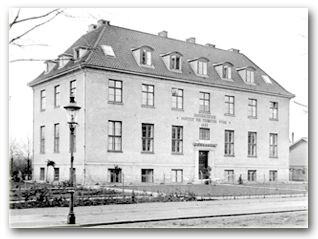The establishment of an institute
During the first forty years (1921-1962), the history of the Institute for theoretical Physics (renamed the Niels Bohr Institute in 1965) can hardly be distinguished from a biography of Niels Bohr.
 It was Bohr himself who sought its establishment and came to define its activities. His immense physical and mental energy and enthusiasm enabled him both to secure the necessary support for his institute and to encourage the informal atmosphere and scientific collaboration among the younger guard of elite physicists that it would be renowned for.
It was Bohr himself who sought its establishment and came to define its activities. His immense physical and mental energy and enthusiasm enabled him both to secure the necessary support for his institute and to encourage the informal atmosphere and scientific collaboration among the younger guard of elite physicists that it would be renowned for.
Soon after being appointed professor at the University of Copenhagen in 1916, Bohr began lobbying for an institute devoted to theoretical physics. His extensive application to the science faculty for the purpose is dated 18th of April 1917.
Money raised from a private group smoothed the path toward the realisation of the institute, and after a few hurdles, especially with regard to obtaining a site, a proposal for the institute was tabled in Parliament at the end 1918. Social unrest and severe inflation brought further problems, but with additional support from the Carlsberg Foundation, the institute could be formally opened on 3rd of March 1921.
By then Niels and Margrethe Bohr and their three sons had moved into the flat on the first floor, and research and teaching had started. Although small in number, the people working at the institute exemplify the international character of the institute, which Bohr developed further over the the following years.
Bohr was able to create a veritable international Mecca for theoretical physics, a tradition that continues at the institute today.
Finn Aaserud, historian of science, director of the Niels Bohr Archive
